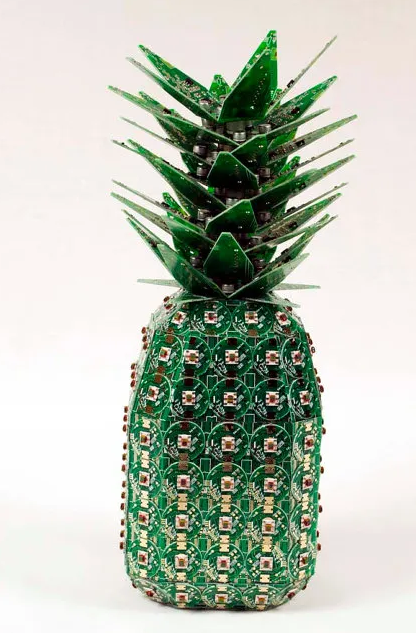The GEEN 1400 Special
This piece uses e waste to create cool looking patterns which highlights the industrialism and cubism aesthetics.
The Aesthetic
Art pieces like Steven Rodria’s Piña Data initially inspired me. I had a lot of extra PCBs from an older project at home and I put the two together and wanted to create similar artwork. I was in a unique position where I had lots of the same PCB assembly and I wanted to create similar patterns to Rodira’s artwork. While I was originally trying to go for more of a colorful circuit board design, I unfortunately left a lot of my PCBs (printed circuit boards) at my home in California and was unable to proceed with my original plan.

So now onto plan B
Since I was originally planning to use PCBs, I knew I would be going for more of an industrialism aesthetic. Industrialism
Characterized by by the use of unfinished materials, exposed structures, and neutral color palettes. [1] The next thing I turned to was these electrical connectors I had leftover from a previous project. These are for connecting wires to PCBs and are pretty common so I bought a bunch in the past since I figured I would use a bunch in the future.

Unfortunately, I have learned that these are counterfeits. The real ones have a slightly different shade of white and have a much more satisfying and secure click when the connectors are mated. In addition, if counterfeits are mixed with genuine parts, this can result in either failure by disconnecting while in service or the connector can get stuck. Because of this, I have stopped using them and these have sat in my junk drawer for several years. I saw this project as the perfect opportunity to get rid of them.
Fabrication
The art piece was assembled using a high temperature molten thermoplastic bonding approach. In other words, I used a hot glue gun and started doing things GEEN 1400 style. This had a main benefit of being a very quick and flexible way to secure parts to each other. This also works well because this is not subjected to high structural loading.

One problem I ran into that I didn’t expect was the packing geometry of the connectors. In the picture below, you can see how a pattern of 3 pin connectors does not fit into a 4 pin pattern. I had originally planned to make multiple cube faces with more parts that were also much larger, however this limited me to much smaller faces. In addition, each face needed a certain number of connectors to be complete and if I ran out of 1, I could no longer expand the project without breaking the pattern.

Final Thoughts
All in all, I was able to bring everything together to come up with the final design shown up top. I learned a lot about planning even in artwork and will try to avoid similar mistakes on the final.



2 Comments. Leave new
I like how industrial and modern your piece of art looks. I thought it was creative to try and create something with the inspiration you had gained from the Pina data art piece, and make do with the materials you had brought with you to design your outcome. if you were to re-design this again would you change anything? if you had the materials you had left in California would you have created a piece of fruit to more closely resemble your inspiration
Cool project, Kyle! It’s awesome to see how you turned e-waste into a piece of art that reflects industrialism and cubism aesthetics. The fabrication process sounds like it was a bit tricky with the packing geometry of the connectors, but you managed to overcome that challenge and create a unique final design. Keep up the great work.